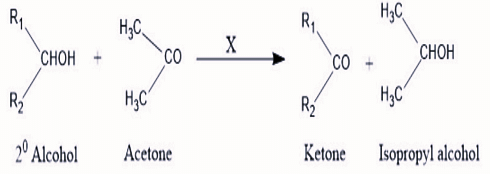Question:
The reaction between ethyl bromide and ethanolic solution of ammonia (excess) is a
The reaction between ethyl bromide and ethanolic solution of ammonia (excess) is a
Show Hint
In nucleophilic substitution reactions, a nucleophile replaces a leaving group (like Br\(^-\)) from an electrophilic carbon center. In this case, ammonia replaces the bromine.
Updated On: May 14, 2025
- Electrophilic substitution
- Electrophilic addition
- Nucleophilic substitution
- Nucleophilic addition
Hide Solution
Verified By Collegedunia
The Correct Option is C
Solution and Explanation
Solution:
When ethyl bromide reacts with an ethanolic solution of ammonia, the reaction proceeds through a nucleophilic substitution mechanism. In this reaction:
- Ethyl bromide (C2H5Br) acts as the substrate, which is an alkyl halide.
- Ammonia (NH3) in ethanolic solution serves as the nucleophile.
- The nucleophile (NH3) attacks the electrophilic carbon atom bonded to the bromine in ethyl bromide, replacing the bromide ion (Br-).
- This results in the formation of ethylamine (C2H5NH2) and the release of a bromide ion.
The overall reaction can be represented as:
C2H5Br + NH3 → C2H5NH2 + HBr
This mechanism involves the substitution of the halide group by a nucleophile, confirming it as a nucleophilic substitution reaction.
Conclusion: The correct option is Nucleophilic substitution.
Was this answer helpful?
0
0
Top Questions on carbonyl compounds
- Which of the following are neutral?
- KEAM - 2025
- Chemistry
- carbonyl compounds
- Acetone can be converted to 2-methylpropan-2-ol using:
- KEAM - 2025
- Chemistry
- carbonyl compounds
- The correct stability order of carbocations is
- JEE Main - 2024
- Chemistry
- carbonyl compounds
- According to Oppenauer Oxidation reaction, oxidation of secondary alcohol to ketone by reagent (X) in acetone takes place, what is "X" :

- GPAT - 2024
- Organic Chemistry
- carbonyl compounds
- The Gattermann-Koch reaction is used in the industrial preparation of benzaldehyde. The electrophile involved in this reaction is
- CUET (UG) - 2024
- Chemistry
- carbonyl compounds
View More Questions
Questions Asked in AP EAPCET exam
- If $$ \int \frac{dx}{1 - \sin^4 x} = A \tan x + B \tan^{-1}(\sqrt{2} \tan x) + C, $$ then find $ A^2 - B^2 $.
- AP EAPCET - 2025
- Integration
- In compound (X), hyperconjugation is present and in (Y), resonance effect is present. What are X and Y, respectively?
- AP EAPCET - 2025
- Organic Chemistry
- A family consists of 8 persons. If 4 persons are chosen at random and they are found to be 2 men and 2 women, then the probability that there are equal numbers of men and women in that family is:
- AP EAPCET - 2025
- Probability
- The total maximum number of electrons possible in 3d, 6d, 5s and 4f orbitals with \(m_l\) (magnetic quantum number) value -2 is
- AP EAPCET - 2025
- Atomic Structure
- If \[ A = \begin{bmatrix} 1 & -1 & 2 \\ -2 & 3 & -3 \\ 4 & -4 & 5 \end{bmatrix} \] and \( A^T \) represents the transpose of \( A \), then calculate \( AA^T - A - A^T \).
- AP EAPCET - 2025
- Matrices
View More Questions